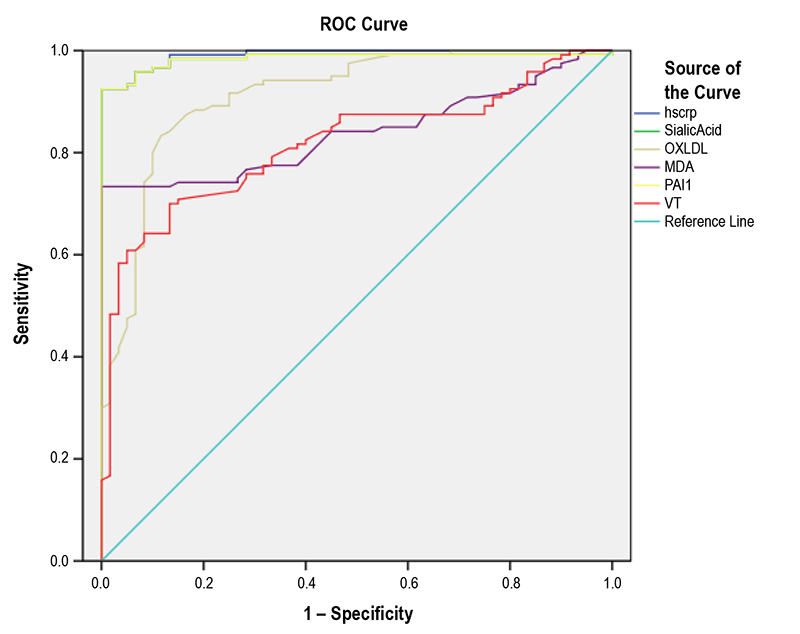Volume 113, Nº 4, October 2019
DOI: http://www.dx.doi.org/10.5935/abc.20190159
ORIGINAL ARTICLE
Evaluation of Serum Levels of Inflammation, Fibrinolysis and Oxidative Stress Markers in Coronary Artery Disease Prediction: A Cross-Sectional Study
Sakhavat Abolhasani
Shahnam Valizadeh Shahbazloo
Hossein Mozafar Saadati
Neda Mahmoodi
Nafiseh Khanbabaei

Figure 1 – ROC analysis of VN, MDA, OX-LDL, PAI-1, hs-CRP and SA. VN: vitronectin; MDA: malondialdehyde; OX-LDL: oxidized low density lipoprotein; PAI-1: plasminogen activator inhibitor-1; hs-CRP: high-sensitivity C-reactive protein; SA: sialic acid.
Abstract
Background: Coronary Artery Disease (CAD) has long been recognized as a global health issue. Inflammation, Fibrinolysis and Oxidative Stress play an important role in the disruption of plaques leading to CAD. Markers that reflect this pathophysiologic mechanism may have prognostic value.
Objective: To estimate the serum concentrations of high-sensitivity C‑reactive protein (hs‑CRP), sialic acid (SA), vitronectin (VN), plasminogen activator inhibitor-1 (PAI-1), oxidized low density lipoprotein (OX-LDL) and malondialdehyde (MDA) with significant prognostic value in patients with CAD.
Methods: The markers included, hs‑CRP, SA, VN, PAI-1, OX-LDL and MDA, were compared between 160 angiographically diagnosed CAD patients and 20 age- and sex-matched healthy individuals. The subjects were divided into 4 groups according to angiography results, and association between all risk factors of CAD was studied. Serum levels of SA, VN, PAI-1, and OX-LDL were measured by enzyme-linked immunosorbent assay (ELISA); MDA was measured based on reaction with thiobarbituric acid (TBA); and hs-CRP level was estimated by immunoturbidimetry using a comercial kit. The diagnostic value of these variables was further assessed by ROC curve analysis. Multiple logistic regression was used to evaluate the diagnostic power of the combination. Furthermore, p < 0.05 was considered as significant.
Results: Serum levels of hs‑CRP, SA, VN, PAI-1, and OX-LDL were significantly higher in patient groups compared to control group (p < 0.001). Using both normal and CAD patients as subjects, ROC analysis was performed. The cutoff for OX-LDL, MDA, PAI-1, VN, hs‑CRP and SA was 2.67 (ug/mL), 5.49 (mmol/mL), 67 (ng/mL), 254 (ng/mL), 3.4 (mg/dL), 7/89 (mg/dL), respectively. Eventually, the complete diagnostic efficacy was classified as: SA, hs‑CRP, PAI-1, OX-LDL, MDA and VN.
Conclusion: Serum levels SA, hs‑CRP, VN, PAI-1, OX-LDL and MDA may be predictive of adverse cardiovascular outcomes. Interestingly, these analyses can help as diagnostic and monitoring markers in CAD patients. (Arq Bras Cardiol. 2019;113(4):667-674)
Keywords: Coronary Artery Disease; Biomarkers; Inflammation Fibrinolysis; Oxidative Stress; Sialic Acids; Vitronectin.















